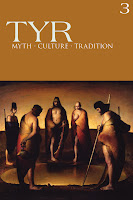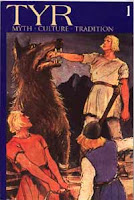In a piece published in 2006 that I have only just read,
Arthur Versluis asserts that the "
battle between modernism and anti-modernism . . . really is the
underlying dynamic of our era." This is one context in which he places Traditionalism.
A bold claim? So it might seem... But then, perhaps he is not actually going too far. A Traditionalist would certainly agree with him. And for non-Traditionalists, what about this? "Antimodernism," writes Versluis, "despite its darker manifestations, also has a bright side that is
fundamental to the creative impulse in modernity.
What contemporary creative work worth its salt does not reflect the tension between modernity and its critique?" Indeed!
That's the more interesting part of this post. Now for a word on the context in which Versluis makes these comments--a review of my
Against the Modern World, published in
Esoterica 8 (2006), pp. 184-88 (the whole volume may be
downloaded). The review is not always favorable, and makes
two criticisms that others have also made, one of which is--I think--more justified that the other. Since
both criticisms have been made before, I will
use this post to respond.
The first criticism is that the book has
relatively little on Traditionalist ideas, as opposed to groups and individuals. That was the result of a deliberate decision I made when writing the book--though the consensus since seems to be that it was not the right decision.
The second criticism is of my
category of "soft" Traditionalism. The question that is normally asked is whether I have been sufficiently rigorous. Writes Versluis:
Dugin . . . almost certainly read Guénon’s Reign of Quantity and the Signs of the Times, for example, before creating his own unique kind of anti-modernism, but I do not think Guénon would recognize himself at all in Dugin’s violent exhortations. . . The mere fact that Dugin may have read this or that work does not make such a work or its author responsible for what Dugin becomes.
There are two questions here. One of them is of how
important Guénon is to Dugin. The other is of whether Guénon is
responsible for Dugin. These two questions are separate.
- The importance of Guénon to Dugin can be discussed, and in fact I did discuss it in more depth in some additional material I prepared for the (forthcoming and currently delayed) Russian translation of Against the Modern World. In short, yes, Guénon was and is important to Dugin, and to the others who I identify as "soft" Traditionalists. To go over all the evidence for each one again would take a lot of space, however.
- Whether Guénon is responsible for Dugin is a different sort of question. Was Marx responsible for what Stalin became? Was François Guizot responsible for what Marx made of his ideas? Was Guizot resposible for starvation in the Ukraine? No--causation and responsibility do not work that way. Stalin, however, can hardly be discussed without reference to Marx, and Marx would have developed different ideas without Guizot.
Versluis has another reason for disliking my category of "soft" Traditionalism, one that has not come up before, and one that provided the immediate context for his comments on the dynamic of our era, quoted above:
One might read the book (wrongly, I trust) as asserting that one can and ought to hunt for signs of indebtedness to Traditionalism in influential authors from Eliade and Scholem to Raine or to Charles, Prince of Wales—and that such signs mark these individuals as being somehow outside the rationalist-empiricist pale. But we don’t need more heretic-hunting of any kind.
Versluis knows about
heretic-hunting. He is, after all, the author of
The New Inquisitions: Heretic-Hunting and the Intellectual Origins of Modern Totalitarianism (New York: Oxford University Press, 2006)--a book that, incidentally, has a favorable endorsement from me on the back cover.
Well, yes, I
do think Eliade was
indebted to Traditionalism,
and Charles, Prince of Wales, as well. Not Scholem--I never said that. Not Raine, either--similar sources to Guénon's, as I said in
Against the Modern World, but not Guénon himself.
Whether being a Traditionalist, hard or soft, places one
outside the rationalist-empiricist pale depends on how that pale is drawn. And how that pale is to be drawn is perhaps--to borrow from Versluis's phrase--one of the central questions of our era. If the pale is drawn very tightly, then yes, Eliade and Guénon, and also Raine and Herman Hesse and Doris Lessing, are all outside it. Along, perhaps, with anyone who goes to church, reads the astrology column in their daily newspaper, or writes poetry. And some have indeed tried to draw the pale very tightly--too tightly, to judge from the current very general reaction against such definitions.
There is always
a risk of heretic-hunting, I agree. It happened to Eliade in old age (I actually defend Eliade's memory against many of the charges brought against him). It was to avoid the risk of heretic-hunting that almost no scholars who are still making their careers are identified as Traditionalists in
Against the Modern World. But then again, I think it is possible to go too far the other way. I will take the example of esotericism in general. For two centuries, scholars have kept quiet about the esoteric interests of a a staggering array of modern heroes. That is one reason why esoteric interests have not been seen as respectable. If it were better known how common such interests were, could they remain so unrespectable?

 Crowley was an important member of the Golden Dawn, which he had joined in 1898, but left the order well before this period.
Crowley was an important member of the Golden Dawn, which he had joined in 1898, but left the order well before this period.































